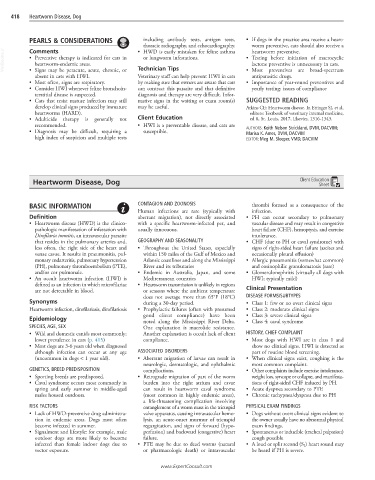Page 865 - Cote clinical veterinary advisor dogs and cats 4th
P. 865
418 Heartworm Disease, Dog
PEARLS & CONSIDERATIONS including antibody tests, antigen tests, • If dogs in the practice area receive a heart-
thoracic radiography, and echocardiography. worm preventive, cats should also receive a
Comments
VetBooks.ir • Preventive therapy is indicated for cats in Technician Tips • Testing before initiation of macrocyclic
• HWD is easily mistaken for feline asthma
heartworm preventive.
or lungworm infestations.
lactone preventive is unnecessary in cats.
heartworm-endemic areas.
• Signs may be peracute, acute, chronic, or
absent in cats with HWI. Veterinary staff can help prevent HWI in cats • Most preventives are broad-spectrum
antiparasitic drugs.
• Most often, signs are respiratory. by making sure that owners are aware that cats • Importance of year-round preventives and
• Consider HWI whenever feline bronchoin- can contract this parasite and that definitive yearly testing: issues of compliance
terstitial disease is suspected. diagnosis and therapy are very difficult. Infor-
• Cats that resist mature infection may still mative signs in the waiting or exam room(s) SUGGESTED READING
develop clinical signs produced by immature may be useful. Atkins CE: Heartworm disease. In Ettinger SJ, et al,
heartworms (HARD). editors: Textbook of veterinary internal medicine,
• Adulticide therapy is generally not Client Education ed 8, St. Louis, 2017, Elsevier, 1316-1343.
recommended. • HWI is a preventable disease, and cats are
• Diagnosis may be difficult, requiring a susceptible. AUTHORS: Keith Nelson Strickland, DVM, DACVIM;
Marisa K. Ames, DVM, DACVIM
high index of suspicion and multiple tests EDITOR: Meg M. Sleeper, VMD, DACVIM
Heartworm Disease, Dog Client Education
Sheet
BASIC INFORMATION CONTAGION AND ZOONOSIS thrombi formed as a consequence of the
Human infections are rare (typically with infection.
Definition aberrant migration), not directly associated • PH can occur secondary to pulmonary
• Heartworm disease (HWD) is the clinico- with a specific heartworm-infected pet, and vascular disease and may result in congestive
pathologic manifestation of infestation with usually innocuous. heart failure (CHF), hemoptysis, and exercise
Dirofilaria immitis, an intravascular parasite intolerance.
that resides in the pulmonary arteries and, GEOGRAPHY AND SEASONALITY • CHF (due to PH or caval syndrome) with
less often, the right side of the heart and • Throughout the United States, especially signs of right-sided heart failure (ascites and
venae cavae. It results in pneumonitis, pul- within 150 miles of the Gulf of Mexico and occasionally pleural effusion)
monary endarteritis, pulmonary hypertension Atlantic coastlines and along the Mississippi • Allergic pneumonitis (somewhat common)
(PH), pulmonary thromboembolism (PTE), River and its tributaries and eosinophilic granulomatosis (rare)
and/or cor pulmonale. • Endemic in Australia, Japan, and some • Glomerulonephritis (virtually all dogs with
• An occult heartworm infection (HWI) is Mediterranean countries HWI; typically mild)
defined as an infection in which microfilariae • Heartworm transmission is unlikely in regions Clinical Presentation
are not detectable in blood. or seasons where the ambient temperature
does not average more than 65°F (18°C) DISEASE FORMS/SUBTYPES
Synonyms during a 30-day period. • Class 1: few or no overt clinical signs
Heartworm infection, dirofilariasis, dirofilariosis • Prophylactic failures (often with presumed • Class 2: moderate clinical signs
good client compliance) have been • Class 3: severe clinical signs
Epidemiology noted along the Mississippi River Delta. • Class 4: caval syndrome
SPECIES, AGE, SEX One explanation is macrolide resistance.
• Wild and domestic canids most commonly; Another explanation is occult lack of client HISTORY, CHIEF COMPLAINT
lower prevalence in cats (p. 415) compliance. • Most dogs with HWI are in class 1 and
• Most dogs are 3-6 years old when diagnosed show no clinical signs. HWI is detected as
although infection can occur at any age ASSOCIATED DISORDERS part of routine blood screening.
(uncommon in dogs < 1 year old). • Aberrant migration of larvae can result in • When clinical signs exist, coughing is the
neurologic, dermatologic, and ophthalmic most common complaint.
GENETICS, BREED PREDISPOSITION complications. • Other complaints include exercise intolerance,
• Sporting breeds are predisposed. • Retrograde migration of part of the worm weight loss, syncope or collapse, and manifesta-
• Caval syndrome occurs most commonly in burden into the right atrium and cavae tions of right-sided CHF induced by PH.
spring and early summer in middle-aged can result in heartworm caval syndrome • Acute dyspnea secondary to PTE
males housed outdoors. (most common in highly endemic areas), • Chronic tachypnea/dyspnea due to PH
a life-threatening complication involving
RISK FACTORS entanglement of a worm mass in the tricuspid PHYSICAL EXAM FINDINGS
• Lack of HWD-preventive drug administra- valve apparatus, causing intravascular hemo- • Dogs without overt clinical signs evident to
tion in endemic areas. Dogs most often lysis, an acute-onset murmur of tricuspid the owner usually have no abnormal physical
become infected in summer. regurgitation, and signs of forward (hypo- exam findings.
• Signalment and lifestyle: for example, male perfusion) and backward (congestive) heart • Spontaneous or inducible (tracheal palpation)
outdoor dogs are more likely to become failure. cough possible
infected than female indoor dogs due to • PTE may be due to dead worms (natural • A loud or split second (S 2 ) heart sound may
vector exposure. or pharmacologic death) or intravascular be heard if PH is severe.
www.ExpertConsult.com

